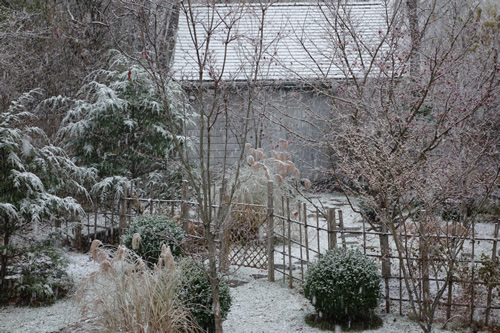
First winter storm
The first winter storm has arrived. The garden has been swept clean of leaves and we’re ready for the long, cold months ahead. The winter garden is very beautiful with just the first dusting of snow. It’s at this time that we see clearly how the evergreens and fence give the garden its structure. By mid-summer they will have faded into the background hidden by lush ferns, grasses, shrubs, and trees.
It’s a small garden and I had endless design possibilities. I could have created a formal English style garden or even modeled the backyard on my favorite Japanese designer Mirei Shigemori’s checkerboard moss garden. But the essence of this garden is contemplative. It should feel as though one were walking on a path to a rustic retreat in the mountains.

Mirei Shigemori’s moss garden in Japan

A formal English garden would fit in my backyard but the style would change the entire feeling of the space.
Jiny Blom, a well known landscape designer said “Take risks. If someone tells you something is impossible, see if you can do it. Gardening is a knife edge between disaster and serendipity.”
I felt she was talking directly to me when I built this stone path.
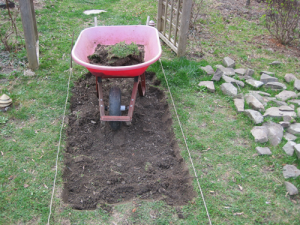
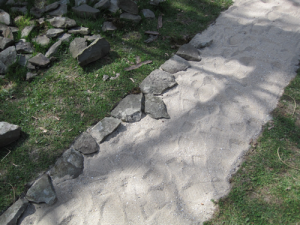
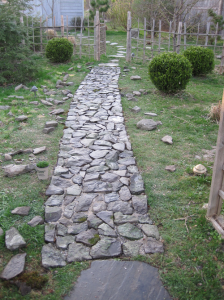
I collected the rocks from an old stone wall on my mother’s property. I dug a trench 8 inches deep and filled it with 800 pounds of rock dust and sand, then pieced the stones together like a quilt or jigsaw puzzle.
Rikyu, the brilliant tea master of the 16th century, said that the design of the Roji should be sixty percent practical and forty percent aesthetic. This path meets his criteria.
I’ve planted creeping thyme in the spaces between the stones. I wasn’t sure it would like the conditions: was there enough light, was the soil too sandy, did it drain well enough…? It’s taken a couple of years but slowly the thyme is making itself at home.
The path needs periodic weeding. I get down on my hands and knees, my nose inches from the stones and delicatly separate the weeds from the thyme. It’s a garden job that could easily be forgotten or put aside as too much trouble, but in the late afternoon when the light is gentle and the air soft, to get down on the ground inches from the earth is a task I’m grateful for.
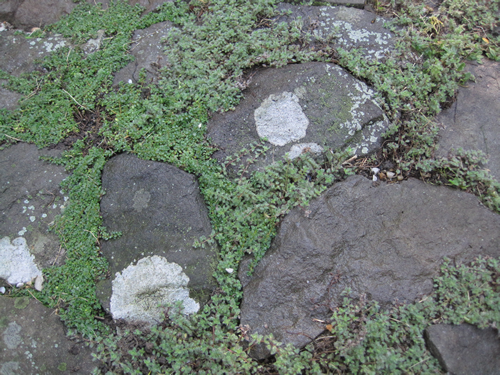
– excerpt from A Tea Garden in Tivoli
Finally spring is here. Temperatures today were in the 70’s. Low tonight in the 40’s. I’ve finally turned off my heat.
Most everything in the garden is showing signs of life.

Here’s my ‘to do list’ for the next day or two…
1) Leigh – ask to borrow his seiza bench for Ron
2) Shim up arbor which fell down with hurricane Sandy
3) Clean out tuskubai (water basin)
4) Retie fence with black twine
4) Mulch woodland bed
5) Trim grass around beds
6) Get the umbrella out from the basement to put on porch table
7) Candle both J. Pines
8) Photograph porch bed so in the fall will know where to plant blubs
9) Next year make sure to prune willow by fence
10) More woodland phlox in the outer roji –
…and on it goes.
Making a garden is no small thing nor is it one big ‘fix’. It takes years of living day to day, thinking about it and asking questions:
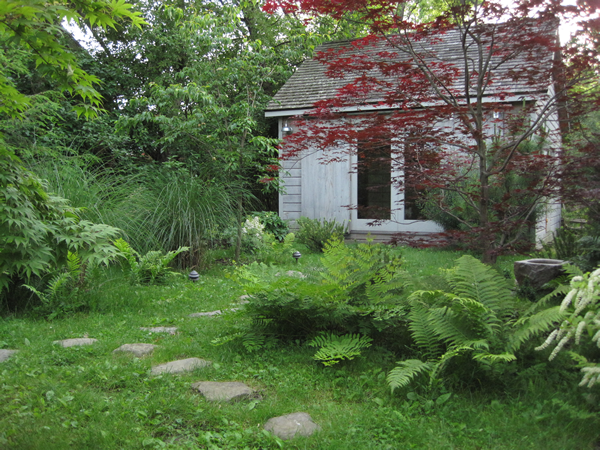
I first learned to garden when I lived at Green Gulch Zen Center in California. Green Gulch is a working organic farm that grows vegetables and flowers for market. I learned about Biodynamic farming, watched gardeners plant seeds in rows of dark rich earth, walked by steaming hot compost piles and weeded in the flower gardens.
Zen is known for its close relationship with the arts, in particular gardening, poetry, calligraphy and the tea ceremony. As part of my Zen practice I have been studying the Way of Tea for many years. This study includes flower arranging, garden design, architecture, literature, the connoisseurship of the fine and applied arts and cuisine. Kaiseki cuisine is a seven course meal served during a tea gathering and in 1997 I wrote a book about it called The World in a Bowl of Tea.
When I moved to my home in Tivoli, New York I continued my Tea and Zen practice and built a small tea house in my back yard. One important element in any Tea gathering is the garden and the path to the tea house, called a Roji. To learn more about this I went to Japan to study Japanese garden design at Kyoto University of Art and Design.
It was my first trip to Japan and I felt completely at home. At last I could walk through the gardens I had heard so much about. I wandered through ancient temples and drank in the atmosphere of the timeless spaces.
This is the story of how I built a Tea house in my backyard and how I created the gardens that surround it. I incorporate many of the ideas of the wild garden, the English cottage garden, the prairie garden all the while working within the rustic, elegant style of the Tea Ceremony.
excerpt – A Tea Garden in Tivoli
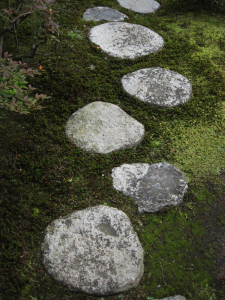 The Tea garden, or Roji is divided into two spaces: an outer garden and an inner garden connected by a series of stone paths. Gates and fences play an important role in dividing the two rooms to create the feeling of transition from one place to another.
The Tea garden, or Roji is divided into two spaces: an outer garden and an inner garden connected by a series of stone paths. Gates and fences play an important role in dividing the two rooms to create the feeling of transition from one place to another.
When designing the landscape for a Tea garden I start by looking at the architecture of the place, the bones and details, because I want to gracefully transition from outer to inner, from the street to the tea house; a transition from daily life to a space that is contemplative and feels connected to place.
It is not necessary to have a tea house or retreat space in your back yard, but the garden should feel like you’ve stepped onto a path that leads you through the countryside to a rustic hut or space designed for quiet contemplation and reflection.
The overall impression should be one of integrity, tranquility and beauty. There are a few elements that make this work.
-excerpt from A Tea Garden in Tivoli

















